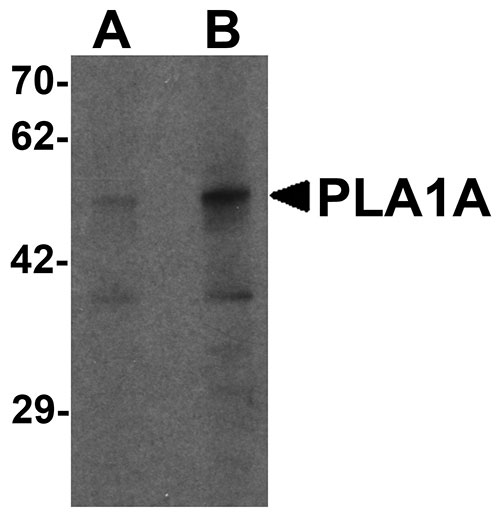PLA1A Antibody
- 产品详情
- 实验流程
- 背景知识
Application
| WB, IF, E |
|---|---|
| Primary Accession | Q53H76 |
| Other Accession | NP_056984, 7706661 |
| Reactivity | Human, Rat |
| Host | Rabbit |
| Clonality | Polyclonal |
| Isotype | IgG |
| Calculated MW | 49715 Da |
| Concentration (mg/ml) | 1 mg/mL |
| Conjugate | Unconjugated |
| Application Notes | PLA1A antibody can be used for detection of PLA1A by Western blot at 1 - 2 µg/mL. For immunofluorescence start at 20 µg/mL. |
| Gene ID | 51365 |
|---|---|
| Other Names | Phospholipase A1 member A, 3.1.1.-, Phosphatidylserine-specific phospholipase A1, PS-PLA1, PLA1A, NMD, PSPLA1 |
| Target/Specificity | PLA1A; At least three isoforms of PLA1A are known to exist; this antibody will detect all three isoforms. |
| Reconstitution & Storage | PLA1A antibody can be stored at 4℃ for three months and -20℃, stable for up to one year. As with all antibodies care should be taken to avoid repeated freeze thaw cycles. Antibodies should not be exposed to prolonged high temperatures. |
| Precautions | PLA1A Antibody is for research use only and not for use in diagnostic or therapeutic procedures. |
| Name | PLA1A (HGNC:17661) |
|---|---|
| Synonyms | NMD, PSPLA1 |
| Function | Hydrolyzes the ester bond of the acyl group attached at the sn-1 position of phosphatidylserines (phospholipase A1 activity) and 1- acyl-2-lysophosphatidylserines (lysophospholipase activity) in the pathway of phosphatidylserines acyl chain remodeling (PubMed:10196188). Cleaves phosphatidylserines exposed on the outer leaflet of the plasma membrane of apoptotic cells producing 2-acyl-1-lysophosphatidylserines, which in turn enhance mast cell activation and histamine production (By similarity). Has no activity toward other glycerophospholipids including phosphatidylcholines, phosphatidylethanolamines, phosphatidic acids or phosphatidylinositols, or glycerolipids such as triolein (By similarity). |
| Cellular Location | Secreted {ECO:0000250|UniProtKB:P97535}. |
| Tissue Location | Widely expressed. Expressed in placenta, prostate and liver. Weakly or not expressed in skin, leukocytes, platelets, colon, spleen, lung, muscle and kidney. |
For Research Use Only. Not For Use In Diagnostic Procedures.
Provided below are standard protocols that you may find useful for product applications.
BACKGROUND
PLA1A Antibody: PLA1A is a phospholipase that hydrolyzes fatty acids at the sn-1 position of phosphatidylserine and 1-acyl-2-lysophosphatidylserine. This secreted protein hydrolyzes phosphatidylserine (PS) in liposomes and can also hydrolyze PS in apoptotic cells and activate platelets where the resulting 2-acyl-lysophosphatidylserine acts as a lipid mediator for mast cells, T cells, and neural cells, suggesting that a major function of PLA1A may be the production of lysophospholipid mediators. PLA1A is upregulated in rat peripheral blood cells bearing long-term surviving cardiac allograft. PLA1A is also expressed in human THP-1-derived macrophages and this expression is upregulated in cells treated with lipopolysaccharide, a TLR4 ligand. This upregulation is inhibited with corticosteroids, which are often used at high dosages to suppress chronic allograft rejection.
REFERENCES
Sato T, Aoki J, Nagai Y, et al. Serine phospholipid-specific phospholipase A that is secreted from activated platelets. A new member of the lipase family. J. Biol. Chem. 1997; 272:2192-8.
Aoki J, Nagai Y, Hosono H, et al. Structure and function of phosphatidylserine-specific phospholipase A1. Biochim. Biophys. Acta 2002; 1582:26-32.
Hosono H, Homma M, Ogasawa Y, et al. Expression of phosphatidylserine-specific phospholipase A(1) mRNA in human THP-1-derived macrophages. Cell Transplant. 2010; 19:759-64.
终于等到您。ABCEPTA(百远生物)抗体产品。
点击下方“我要评价 ”按钮提交您的反馈信息,您的反馈和评价是我们最宝贵的财富之一,
我们将在1-3个工作日内处理您的反馈信息。
如有疑问,联系:0512-88856768 tech-china@abcepta.com.























 癌症的基本特征包括细胞增殖、血管生成、迁移、凋亡逃避机制和细胞永生等。找到癌症发生过程中这些通路的关键标记物和对应的抗体用于检测至关重要。
癌症的基本特征包括细胞增殖、血管生成、迁移、凋亡逃避机制和细胞永生等。找到癌症发生过程中这些通路的关键标记物和对应的抗体用于检测至关重要。 为您推荐一个泛素化位点预测神器——泛素化分析工具,可以为您的蛋白的泛素化位点作出预测和评分。
为您推荐一个泛素化位点预测神器——泛素化分析工具,可以为您的蛋白的泛素化位点作出预测和评分。 细胞自噬受体图形绘图工具为你的蛋白的细胞受体结合位点作出预测和评分,识别结合到自噬通路中的蛋白是非常重要的,便于让我们理解自噬在正常生理、病理过程中的作用,如发育、细胞分化、神经退化性疾病、压力条件下、感染和癌症。
细胞自噬受体图形绘图工具为你的蛋白的细胞受体结合位点作出预测和评分,识别结合到自噬通路中的蛋白是非常重要的,便于让我们理解自噬在正常生理、病理过程中的作用,如发育、细胞分化、神经退化性疾病、压力条件下、感染和癌症。







